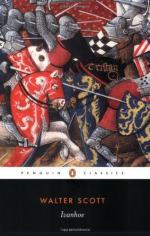|
This section contains 10,023 words (approx. 34 pages at 300 words per page) |

|
SOURCE: "Culture and Economy in Ivanhoe," in Nineteenth-Century Literature, Vol. 42, No. 1, June, 1987, pp. 46-72.
In the following essay, Bossche claims that Ivanhoe, as a work of historical fiction, attempts to bridge the distance between past and present by mingling elements of an earlier culture with more familiar political and social issues.
Sir Walter Scott's Ivanhoe dramatizes culture as a semiotic system that constitutes social relations. The novel's protagonists are not just Cedric, Wilfred, Bois-Guilbert, and Isaac of York, but the languages they speak: Saxon, the lingua franca, Norman, and Hebrew. The theme of language that permeates Ivanhoe is a metaphor for culture, and the novel represents many other semiotic systems, including the cultural codes of etiquette, costume, architecture, cuisine, and economy. The desire to return to cultural and economic stability, when conflicts between cultures undermine the stability of each system, motivates the conclusion of the novel, the resolution...
|
This section contains 10,023 words (approx. 34 pages at 300 words per page) |

|


